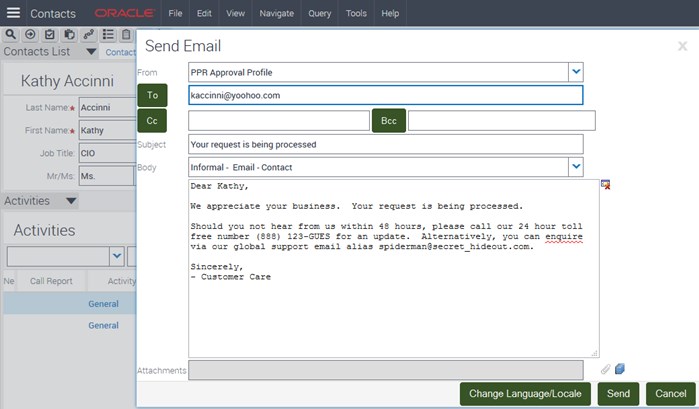Always create system of record for outbound emails
You can send emails from Siebel application in more than one way -
- Hit F9 on any record.
Provided the record type is enabled for email sending, F9 will open up a popup applet where you can select the email recipient, template, make changes to final email and finally send the email. - Install Siebel Desktop and use Outlook to send emails.
- Send alerts, notifications, escalations and a bunch of other interesting stuff using workflows or business services (OOB or custom)

Sending emails through user action from the application typically creates an activity. This activity is configurable to an extent (look up System Activity Objects to configure relevant fields in activities created by F9).
You also find the outbound communication sent in “All Outbound Requests” view.

In the normal world, these stay as records and do not contribute anything more towards resolving life’s issues.
But, it can become a costly mistake if you decide to bypass this for any reason.
Developers can think in a couple of innovative ways here..
- Improve performance by eliminating unneeded steps. Creation of activity or Outbound Communication Request is time consuming.
- Remove all steps that add to the database size “needlessly”
Since the OOB actions do not yield to full customization, they tend to use underlying objects/services to change things.
For e.g. you can use “SendMessage” of “Outbound Communications Manager” business service to send emails. This will not create any activities or even outbound communication requests within application.
And, this has proved to be a costly mistake again and again.
- You cannot track failures.
Although this looks silly, the email sending process has couple of hoops. Siebel application makes a couple of requests internally, and finally to the SMTP server. There are ways in which this process can fail.
Although infrequent, loss of emails may lead to potential loss of business - or worse. - There is no system of record to see past emails.
There may be legal or regulatory implications of not tracking emails sent to customers, partners, or to employees. - SMTP cannot be trusted!
While SMTP servers keep logs of what is being sent out, they do not offer an easy solution to search, track and take action on historical emails. You will also struggle to establish connection between emails and the actions in Siebel.
The simplest solution of course is to fall back on traditionally used methods to send emails.
In the above example, try using “Submit Request” or “Create and Submit Request” methods of “Outbound Communications Manager” business service instead of “Send Message”. This will create an activity and an outbound communication request as expected.